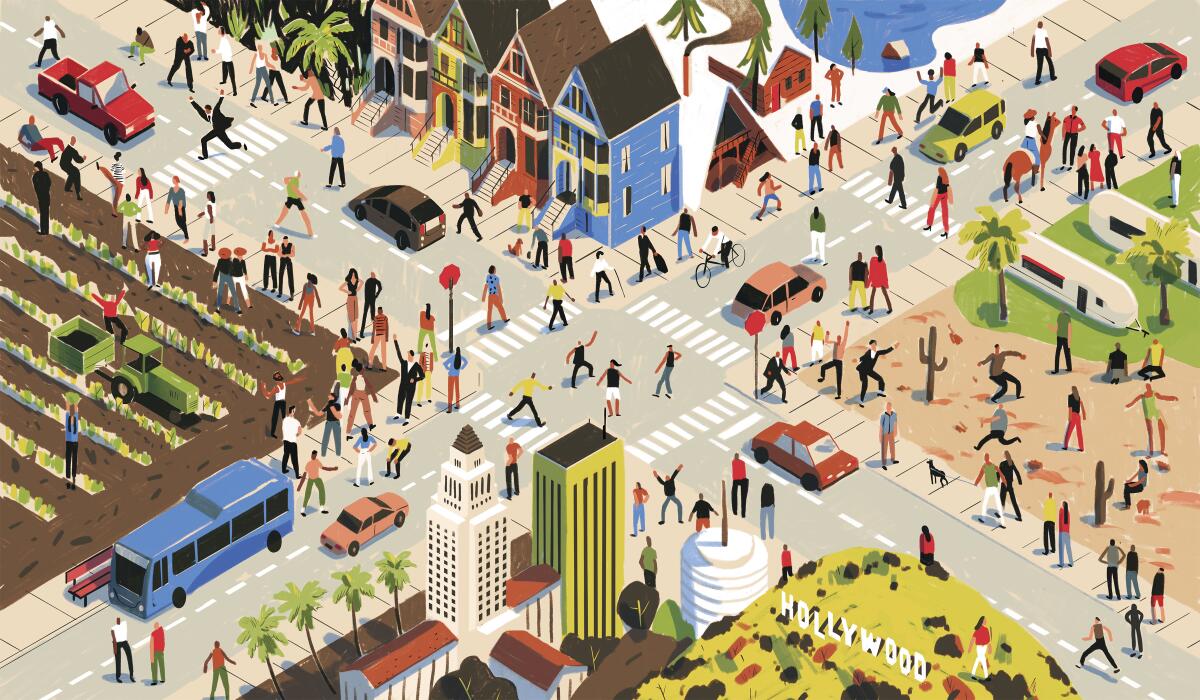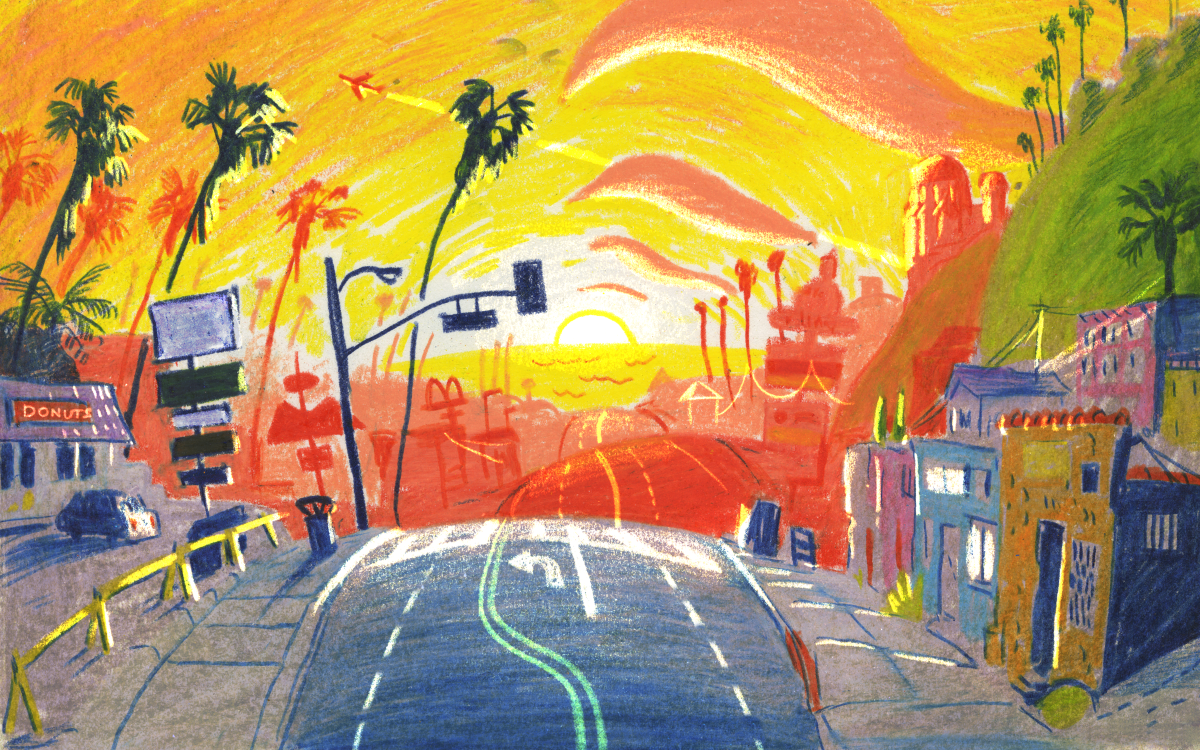What’s driving those moving to, from or across California? We want to hear from you

- Share via
Good morning, and welcome to the Essential California newsletter. It’s Thursday, April 6.
New census data is giving us a sense of how populations across the state ebbed and flowed in the first couple of years of the COVID-19 pandemic.
The early stages of the pandemic (2020 to mid-2021) marked an exodus of residents from more populous urban counties such as Los Angeles and San Francisco.
But that exodus slowed over the following year into mid-2022. Some counties that had lost residents are beginning to build back their populations, while some more rural counties are experiencing a decline in residents.
“The big takeaway,” my colleague Terry Castleman reported this week:
“Californians relocated quite a bit in response to the pandemic and other factors but many counties are now starting to resettle into the pre-pandemic status quo.”
By the numbers
Between July 2021 and July 2022, the 10 counties with the highest rates of population loss were:
- Lassen County: -6%
- Alpine County: -3.64%
- Plumas County: -2.95%
- Sierra County: -2.36%
- Mono County: -2.13%
- Trinity County: -1.74%
- Del Norte County: -1.71%
- Napa County: -1.40%
- Mendocino County: -1.34%
- San Mateo County: -1.34%
In that same time period, the 10 counties with the top rates of population gain were:
- Yolo County: +4.26%
- Merced County: +1.95%
- Santa Cruz County: +1.49%
- Santa Barbara County: +1.46%
- San Benito County: +1.36%
- Yuba County: +1.31%
- Placer County: +1.20%
- San Luis Obispo County: +0.97%
- Madera County: +0.85%
- Riverside County: +0.84%
Statewide, California’s rate of population loss also slowed — from a 0.91% drop in the first year of that data set to a 0.29% decline over the second year.
So what’s driving these more recent shifts? That varies county to county. Influences experts and officials point to include some job sectors returning to in-person work, students returning to college towns, prison closures (meaning many incarcerated people are no longer residents) and more affordable housing options in some suburbs.
Paul Ong, director of the Center for Neighborhood Knowledge at UCLA, told Terry that cities have “once again become appealing to a new generation of young workers.”
But despite slowing the loss of residents, cities are struggling. Issues such as housing, public safety and remote work’s effects on commuting are affecting their bottom lines. That’s raising concerns among some economists of a “doom loop” that could undo decades of urban renewal, causing even more city dwellers to head for the suburbs.
When we asked early last month how the COVID-19 emergency had changed Californians’ lives, some of you shared your experiences moving — across, into or out of California — for jobs, retirement or to be closer to family.
The census data provide some broad strokes, but to get the details, we’re turning to your personal experiences again. So tell us:
Have you moved from one California county or another — or out of state entirely — since the pandemic started? What fueled your decision?
And if you haven’t moved, what changes have you noticed in your community as some residents move out or others move in?
Our goal is to feature as many of your submissions as we can in an upcoming edition of the newsletter, so please keep your responses under 150 words.
Take our survey to share your experience and stay tuned to see your responses featured in an upcoming edition of Essential California.
And now, here’s what’s happening across California:
Note: Some of the sites we link to may limit the number of stories you can access without subscribing.
L.A. STORIES
Anyone who says “no one walks in L.A.” never met Pedro Moura and his friends. Last month, they put one foot in front of the other for the 25-mile journey along Sunset Boulevard from Chinatown to where it meets Pacific Coast Highway. “At times, walking this city feels like disobeying its well-orchestrated wishes,” Moura wrote this week for The Times. “Wouldn’t this place be a lot better if it were a little easier to experience on foot?” Los Angeles Times

A new Los Angeles tax on large property sales designed to boost funding to address homelessness took effect Saturday but faces legal limbo. The so-called mansion tax faces a pair of lawsuits, leaving city officials to weigh whether they should start spending new revenue they could have to pay back later if they lose in court. LAist
Early-1900s L.A. was rich in private social clubs, fueled by Angelenos’ desire for belonging. But as Patt Morrison explored, the history of many organizations was rife with exclusion of women and minority groups. Los Angeles Times
Check out "The Times" podcast for essential news and more
These days, waking up to current events can be, well, daunting. If you’re seeking a more balanced news diet, “The Times” podcast is for you. Gustavo Arellano, along with a diverse set of reporters from the award-winning L.A. Times newsroom, delivers the most interesting stories from the Los Angeles Times every Monday, Wednesday and Friday. Listen and subscribe wherever you get your podcasts.
POLITICS AND GOVERNMENT
A new effort is underway to provide California’s undocumented farmworkers a path to citizenship. The bill from state Sen. Anna Caballero (D-Merced) would create a pilot program, allowing “our undocumented friends, family and neighbors to come out of the shadows, to live lives free of fear and allow them to qualify for the safety net programs that they deserve and pay into,” she said in a statement. Fresno Bee
It’s a crucial moment for the future of public transit in the state. With ridership and revenue down dramatically and pandemic emergency funding from the feds ending, many agencies are weighing options to cut service and/or increase fares. CalMatters
Gov. Gavin Newsom spent the early part of this week on his Campaign for Democracy tour, a trip to some red states he says are “experiencing a massive roll back of freedoms led by the GOP.” On Wednesday he met with students of New College of Florida, the small liberal arts school undergoing a dramatic shift in leadership, orchestrated by Gov. Ron DeSantis. Sacramento Bee
CRIME, COURTS AND POLICING
Wage theft is rampant among garment industry employers in Southern California, according to a recent federal labor report. Labor Department officials surveyed more than 50 contractors and manufacturers and found more than 80% violated the Fair Labor Standards Act. “In a particularly egregious case ... a contractor paid garment workers as little as $1.58 per hour,” officials said. Los Angeles Times
A San Francisco-based digital library was dealt a major blow in a court battle that could affect similar online archives across the country. A federal judge sided with publishers in a multimillion-dollar copyright infringement lawsuit against the Internet Archive, which temporarily allowed unrestricted access to online books in the early days of the pandemic. KQED
Support our journalism
HEALTH AND THE ENVIRONMENT
The Bay Area is set to add about 2,000 acres of protected green space. Conservationists recently finalized the $22.4-million purchase of Lakeside Ranch south of San Jose, and their plan is to keep the rural property in its mostly natural state — plus add some hiking trails. San Francisco Chronicle
Most of California’s COVID-19 rules have eased with the state lifting its pandemic emergency declaration. But some counties still have some of their own guidelines in place, including rules for masking in healthcare settings, time frames for quarantine or isolation, and reporting new infections and outbreaks. Here’s what’s changed in L.A. County. Los Angeles Times
CALIFORNIA CULTURE
Photographers in San Francisco will be taking advantage of a rare opportunity this weekend: capturing the “California Henge.” Saturday’s sunrise is set to to align just right with the city’s street grid, providing a stunning view (weather permitting) available only twice a year. Los Angeles Times
Free online games
Get our free daily crossword puzzle, sudoku, word search and arcade games in our new game center at latimes.com/games.
AND FINALLY
Today’s California landmark comes from Frank Damon of Pacific Palisades: Carrizo Plain National Monument.

Frank writes:
Carrizo Plain National Monument is about 150 miles northwest of Los Angeles in a valley between Bakersfield and San Luis Obispo. It was probably formed by the San Andreas Fault and natural erosion over thousands of years. Formerly the home of grazing elk and antelope, it is now the home of spectacular and colorful wildflowers during the spring. And this year, after the record rainfall, they are spectacular!
What are California’s essential landmarks? Fill out this form to send us your photos of a special spot in California — natural or human-made. Tell us why it’s interesting and what makes it a symbol of life in the Golden State. Please be sure to include only photos taken directly by you. Your submission could be featured in a future edition of the newsletter.
Please let us know what we can do to make this newsletter more useful to you. Send comments to essentialcalifornia@latimes.com.
Sign up for Essential California
The most important California stories and recommendations in your inbox every morning.
You may occasionally receive promotional content from the Los Angeles Times.







